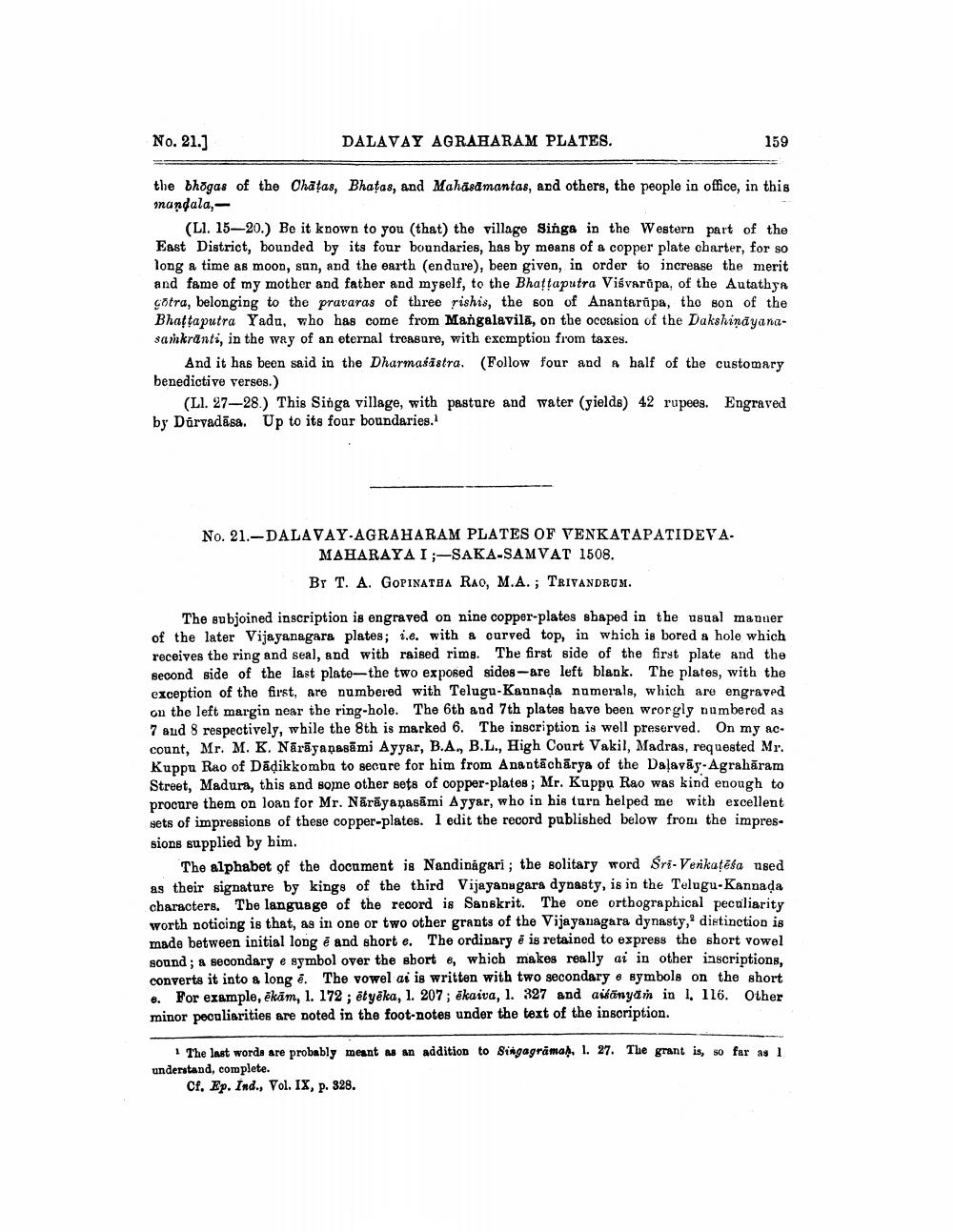________________
No. 21.]
DALAVAY AGRARARAM PLATES.
159
the bhogas of the Chāļas, Bhatas, and Mahäsdmantas, and others, the people in office, in this mandala,
(LI. 15-20.) Be it known to you (that) the village Singa in the Western part of the East District, bounded by its four boundaries, has by means of a copper plate charter, for so long a time as moon, sun, and the earth (endure), been given, in order to increase the merit and fame of my mother and father and myself, to the Bhattaputra Visvarūpa, of the Autathya cotra, belonging to the pravaras of three rishis, the son of Anantarūpa, the son of the Bhattaputra Yada, who has come from Mangalavilā, on the occasion of the Dakshinayanasankranti, in the way of an eternal treasure, with exemption from taxes.
And it has been said in the Dharmasastra. (Follow four and a half of the customary benedictive verses.)
(Ll. 27-28.) This Singa village, with pasture and water (yields) 42 rupees. Engraved by Dárvadāsa. Up to its four boundaries.
No. 21.-DALAVAY-AGRAHARAM PLATES OF VENKATAPATIDEVA.
MAHARAYAI;-SAKA-SAMVAT 1508. BY T. A. GOPINATOA RAO, M.A.; TRIVANDRUM.
The subjoined inscription is engraved on nine copper-plates shaped in the usual manner of the later Vijayanagara plates; i.e. with a curved top, in which is bored a hole which receives the ring and seal, and with raised rims. The first side of the first plate and the second side of the last plate-the two exposed sides-are left blank. The plates, with the cxception of the first, are numbered with Telugu-Kannada numerals, which are engraved on the left margin near the ring-hole. The 6th and 7th plates have been woorgly numbered as 7 and 8 respectively, while the 8th is marked 6. The inscription is well preserved. On my account, Mr. M. K. Nārāyaṇasāmi Ayyar, B.A., B.L., High Court Vakil, Madras, requested Mr. Kuppu Rao of Dāļikkomba to secure for him from Anantācharya of the Dalavās. Agrahāram Street, Madura, this and some other sets of copper-plates; Mr. Kuppu Rao was kind enough to procure them on loan for Mr. Nārāyanasāmi Ayyar, who in his turn helped me with excellent sets of impressions of these copper-plates. 1 edit the record published below from the impres. sions supplied by him.
The alphabet of the document is Nandinagari; the solitary word Sri-Verkateta used as their signature by kings of the third Vijayanagara dynasty, is in the Telugu-Kannada characters. The language of the record is Sanskrit. The one orthographical peculiarity worth noticing is that, as in one or two other grants of the Vijayanagara dynasty, distinction is made between initial long é and short e. The ordinary é is retained to express the short vowel sound; a secondary e symbol over the sbort e, which makes really ai in other inscriptions, converts it into a long e. The vowel ai is written with two secondary e symbols on the short e. For example, ēkām, 1. 172, ētyēka, 1. 207; ēkaiva, 1. 327 and aitänyam in I. 116. Other minor peculiarities are noted in the foot-notes under the text of the inscription.
1 The last words are probably meant as an addition to Singagrāmas, I. 27. The grant is, so far as I understand, complete.
Cf. Ep. Ind., Vol. IX, p. 328.




